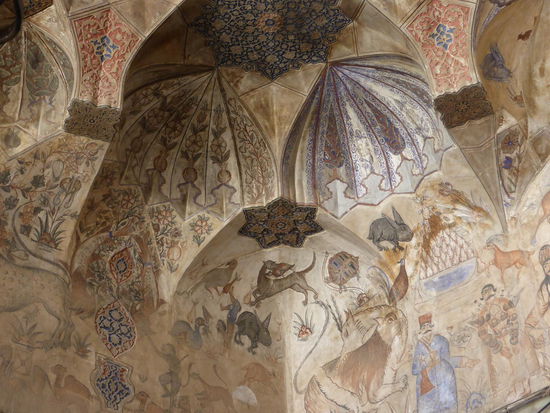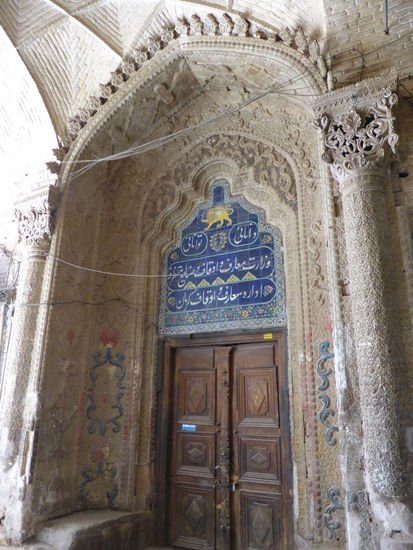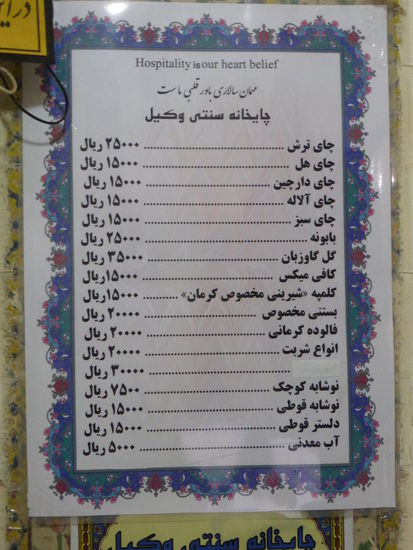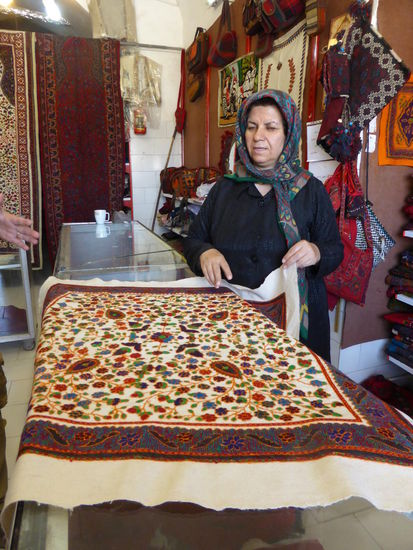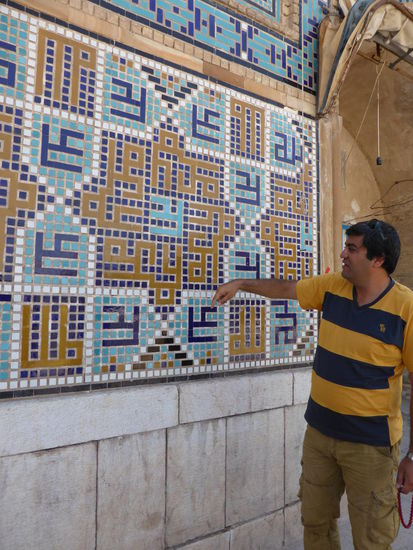Achämeniden, Safawiden und Sassaniden
Kerman
Nach dem Frühstück laufen wir zunächst durch den Basar von Kerman. Es ist ein riesiger Komplex mit sich überkreuzenden bis zu 700m langen überdachten Ladenstraßen, zu dem sowohl mehrere Moscheen als auch Hammam(s) gehört (haben). Man merkt hier, dass es sich um einen reinen Markt für die Bevölkerung handelt, denn es sind keinerlei touristische Artikel zu finden. Wir erstehen echten iranischen Safran und den bestens bekanntem Kerman-Kümmel.
Hammam-e-Ganjali-khan
Als erstes besichtigen wir den in ein Museum umgewandelten Hammam. Wie in einem Wachsfigurenkabinett sind dort Szenen aus dem Hamam früherer Zeiten dargestellt.
Weiter geht es durch den Bazar - vorbei an kleinen Moscheen und verschiedenen Bekleidungsläden.
Hammam-e Vakil
Nach weiteren Besichtigungsgängen führt uns Sami in einen anderen ehemaligen Hammam, der nun als Restaurant umfunktioniert ist.
Nach dem obligatorischen Tee geht es dann weiter zunächst zu einer Stelle, an der hervorragende Stickereidecken hergestellt und verkauft weden.
In der alten Moschee im Bazarkomplex zeigt uns Sami die immer und überall auftauchenden Schriftzüge 'Allah'.
Und schließlich werfen wir - zurück am Eingang - noch einen Blick auf die Kesselflicker, bevor wir gegen 11.00 Uhr etwa 35 km Richtung 'Pakistan' nach Mahan fahren.
Den obligatorischen Tee nehmen wir auf dem Dach zu uns. Dazu werden Kekse und Datteln gereicht. Wir verabschieden unseren Fahrer Ali, der aus privaten Gründen nach Hause zurück muß und albern shisharauchend noch etwas rum.
43486
aus: Tehran Times 12 December 2012
Very lively bazaar of Kerman is the highlight of any visit
A shop in the Coppersmith's Bazaar of Kerman
The desert trading city of Kerman has long been a staging point for people passing between Persia and the Indian subcontinent and today it remains the best place from which to explore southeastern region of the country.
Sheltered from the vast Dasht-e Lut by the barren Payeh Mountains to the north, its position and elevation make the weather relatively mild in summer, but cold in winter. The city is something of a melting pot, blending Persians with the more subcontinental way of life of the Baluchis. This mixing is most evident in the historic and very lively bazaar, which is the highlight of any visit. There are enough other sights to keep you for a day or more.
Kerman's environs are extremely dry and the city - and province to which it gives its name - are highly dependent on qanats (underground water channels).
The Grand Bazaar
Stretching for 1200m, Kerman's Grand Bazaar is one of the oldest trading centers in Iran. This main thoroughfare is made up of four smaller bazaars, and a further 20 or so branch off to the north and south. It is, however, easy enough to navigate and has a vivacity that should keep you interested, especially in the morning and late afternoon.
Starting at Tohid Sq, the first section is the Bazar-e Ganj Ali Khan, built in the 17th century for Ganj Ali Khan (the governor of Kerman), which soon opens onto the pretty Ganj Ali Khan Square. Built in the Safavid period, this courtyard is home to what was once Kerman's most important hammam (bathhouse), the Hamam-e Ganj Ali Khan, now restored and transformed into a museum.
Wonderful frescoes adorn the walls and wax dummies illustrate the workings of a traditional bathhouse. The reception area, for example, was divided so men practicing different trades could all disrobe together. Look for the 'time stones' at the east and west ends of the hammam; translucent, 10cm-thick alabaster doorways through which bathers could get a rough idea of the time according to how light it was outside.
On the north side of the courtyard is the photogenic Bazar-e Mesgari Shomali (Coppersmith's Bazaar), and at the square's northeastern end is Masjed-e Ganj Ali Khan, Ganj Ali Khan's lavishly decorated private mosque. A caravanserai next door was being restored.
From the northeastern corner of the square, the Gold Bazaar (Bazar-e Zargaran) leads to a small square with an attractive portal leading to an old (and now closed) madraseh. Follow the steps down into the Hamam-e Ebrahim Khan, one of Iran's few traditional bathhouses where men can still be rubbed, scrubbed and beaten. The welcoming manager might show visitors around if it's not busy.
The Bazar-e Ekhtiari leads east from the square and passes the Hamam-e Vakil Chaykhaneh before becoming the Bazar-e Vakil; both are about 150 years old. After about 600m the covered bazaar ends and the 700-year-old open-air Bazar-e Mosaffari begins, though there is little evidence of such antiquity. The Jameh Mosque can be entered from this bazaar, and you can then walk through to Shohada Sq.
Imam Mosque
The expansive Imam Mosque is worth a look specifically if you're interested in the process of rehabilitating old buildings. Dating from the early Islamic period, the mosque has suffered considerable damage over the years, not least the destruction of a minaret during an earthquake in the 1970s. But the painstaking restoration goes on with the twin aims of uncovering and restoring early inscriptions while leaving no trace of the recent work. It's quite a challenge. If you get chatting with the architects in charge they might (no guarantees here) let you take a look at the remains of a fine mihrab believed to date from the early Islamic period, locked away in the southwest corner. Also worth finding are the reliefs in the rooms high above the main iwan.
Gonbad-e Jabaliye
At the edge of town is the mysterious, octagonal Gonbad-e Jabaliye, which houses a mildly interesting and poorly labelled museum of old gravestones. It's mysterious because its age and original function remain unknown - a Kerman Tourism brochure sums it up as 'A big, strange dome in the eastern part of Kerman'. Quite! Some scholars date it to the 2nd century AD and think it may have been an observatory. Others say it was a tomb. Whatever its function, it is remarkable because it is constructed of stone rather than the usual brick; though the double-layered dome, added 150 years ago, is brick.
Hamam-e Ganj Ali Khan
Built in the Safavid period, this courtyard is home to what was once Kerman's most important hammam, the Hamam-e Ganj Ali Khan, now restored and transformed into a museum. Wonderful frescoes adorn the walls and wax dummies illustrate the workings of a traditional bathhouse. The reception area, for example, was divided so men practicing different trades could all disrobe together. Look for the 'time stones' at the east and west ends of the hammam; translucent, 10cm-thick alabaster doorways through which bathers could get a rough idea of the time according to how light it was outside.
Moshtari-ye Moshtaq Ali Shah Mausoleum
The attractive Moshtari-ye Moshtaq Ali Shah is the mausoleum for Sufi mystic Moshtaq Ali Shah, and other Kerman notables. Moshtaq Ali Shah was renowned for his singing and ability with the setar (a four-stringed instrument), and is apparently responsible for adding the fourth string to the setar (which literally means 'three strings'). He eventually fell so far out of favor with the local religious community that he was stoned in the Jameh Mosque. Most of what you see, including the prominent blue-and-white-tiled roofs, are from the late Qajar period.
Museum of the Sacred Defense
The Museum of the Sacred Defense commemorates the eight-year Iran-Iraq War. Symbolism abounds, although much of it won't be obvious without an English-speaking guide. Inside is a gallery of gruesome photos, artifacts, letters and documents from the war, and an animated model re-enacting the Karbala V, a famous battle. Outside, along with a line-up of tanks and missile launchers, is a battlefield complete with bunkers, minefield and sound effects recorded from the actual war. Well worth a look.
Museum of Contemporary Art
This newly renovated museum is a pleasant surprise in a town that can otherwise feel a long way from modern cultural pursuits. In a Qajar-era building set around an attractive courtyard, the museum houses paintings, sculptures and stone inlays by famous local artist Sayyed Ali Akbar Sanati (1916-2006). It also has exhibitions by younger Iranian artists and even a bronze hand by Auguste Rodin. Not surprisingly, it's a good place to meet open-minded young Kermanis.
Paleontological Museum
Located underground in green Park-e Sangi, about 500m east of Shohada Sq, the Paleontological Museum is the passion and life's work of local mountaineer Mohsen Tajrobekar. He has collected a stunning array of fossils from the mountains around Kerman and his finds have caused scientists to re-assess the origins of some present-day species. They include a perfectly petrified fish believed to be 530 million years old.
Kerman National Library
The Kerman National Library modestly bills itself as the 'greatest informatic research center in the country', but it's the architecture - a forest of columns supporting vaulted ceilings - that is the real attraction. Built in 1929, the style is a harmonious variation on late-Qajar-era design that was purpose built as, wait for it, a textile factory!
Jameh Mosque
The well-preserved Jameh Mosque is entered from both Shohada Sq and the bazaar. Its four lofty iwans (rectangular halls opening onto a courtyard) and shimmering blue tiles date from 1349 but were extensively modernized during the Safavid period and later. Interestingly, this mosque has no minaret. Instead there is a squat clock tower atop the main entrance (off Shohada Sq).
(Source: Lonely Planet)
| Aufbruch: | 24.05.2014 |
| Dauer: | 3 Wochen |
| Heimkehr: | 14.06.2014 |






